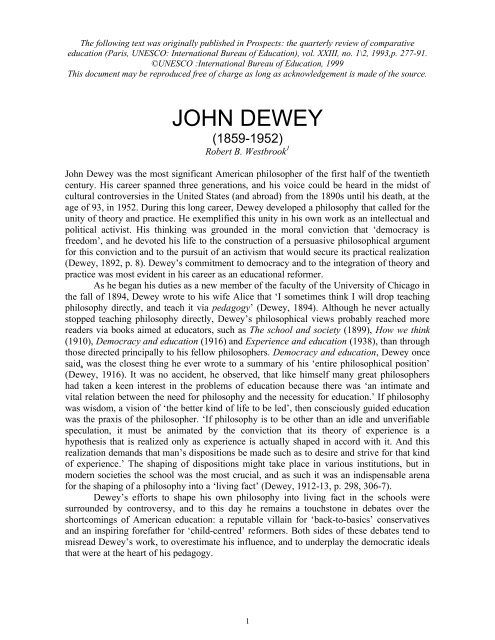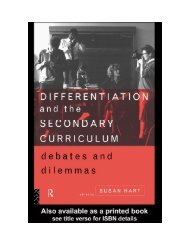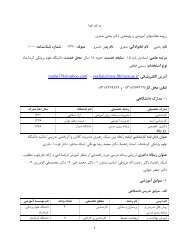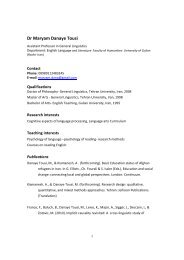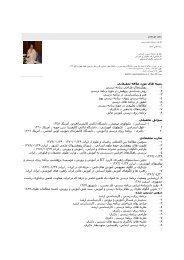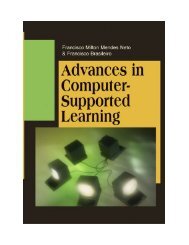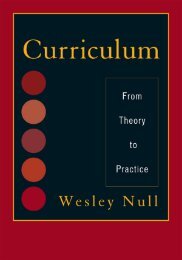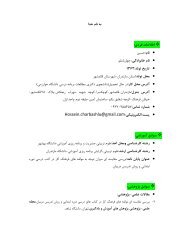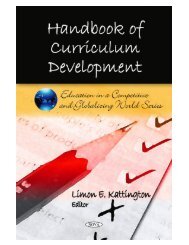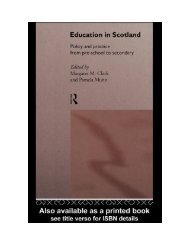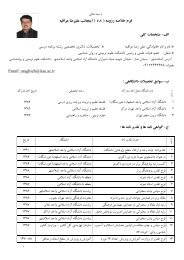JOHN DEWEY
JOHN DEWEY
JOHN DEWEY
Create successful ePaper yourself
Turn your PDF publications into a flip-book with our unique Google optimized e-Paper software.
The following text was originally published in Prospects: the quarterly review of comparativeeducation (Paris, UNESCO: International Bureau of Education), vol. XXIII, no. 1\2, 1993,p. 277-91.©UNESCO :International Bureau of Education, 1999This document may be reproduced free of charge as long as acknowledgement is made of the source.<strong>JOHN</strong> <strong>DEWEY</strong>(1859-1952)Robert B. Westbrook 1John Dewey was the most significant American philosopher of the first half of the twentiethcentury. His career spanned three generations, and his voice could be heard in the midst ofcultural controversies in the United States (and abroad) from the 1890s until his death, at theage of 93, in 1952. During this long career, Dewey developed a philosophy that called for theunity of theory and practice. He exemplified this unity in his own work as an intellectual andpolitical activist. His thinking was grounded in the moral conviction that ‘democracy isfreedom’, and he devoted his life to the construction of a persuasive philosophical argumentfor this conviction and to the pursuit of an activism that would secure its practical realization(Dewey, 1892, p. 8). Dewey’s commitment to democracy and to the integration of theory andpractice was most evident in his career as an educational reformer.As he began his duties as a new member of the faculty of the University of Chicago inthe fall of 1894, Dewey wrote to his wife Alice that ‘I sometimes think I will drop teachingphilosophy directly, and teach it via pedagogy’ (Dewey, 1894). Although he never actuallystopped teaching philosophy directly, Dewey’s philosophical views probably reached morereaders via books aimed at educators, such as The school and society (1899), How we think(1910), Democracy and education (1916) and Experience and education (1938), than throughthose directed principally to his fellow philosophers. Democracy and education, Dewey oncesaid, was the closest thing he ever wrote to a summary of his ‘entire philosophical position’(Dewey, 1916). It was no accident, he observed, that like himself many great philosophershad taken a keen interest in the problems of education because there was ‘an intimate andvital relation between the need for philosophy and the necessity for education.’ If philosophywas wisdom, a vision of ‘the better kind of life to be led’, then consciously guided educationwas the praxis of the philosopher. ‘If philosophy is to be other than an idle and unverifiablespeculation, it must be animated by the conviction that its theory of experience is ahypothesis that is realized only as experience is actually shaped in accord with it. And thisrealization demands that man’s dispositions be made such as to desire and strive for that kindof experience.’ The shaping of dispositions might take place in various institutions, but inmodern societies the school was the most crucial, and as such it was an indispensable arenafor the shaping of a philosophy into a ‘living fact’ (Dewey, 1912-13, p. 298, 306-7).Dewey’s efforts to shape his own philosophy into living fact in the schools weresurrounded by controversy, and to this day he remains a touchstone in debates over theshortcomings of American education: a reputable villain for ‘back-to-basics’ conservativesand an inspiring forefather for ‘child-centred’ reformers. Both sides of these debates tend tomisread Dewey’s work, to overestimate his influence, and to underplay the democratic idealsthat were at the heart of his pedagogy.1
The making of an educatorJohn Dewey was born in Burlington, Vermont, in 1859, the son of a storekeeper. Hegraduated from the University of Vermont in 1879, and after a brief career as a schoolteacherin Pennsylvania and Vermont, he enrolled as a graduate student in the department ofphilosophy at Johns Hopkins University, which had pioneered graduate education on theGerman model in the United States. There he came under the influence of George S. Morris,a neo-Hegelian idealist. After receiving his Ph.D. in 1884 with a dissertation on ‘Kant’sPsychology’, Dewey followed Morris to the University of Michigan, and assumed leadershipof the philosophy department there in 1889.While at Michigan, Dewey met his future wife, Alice Chipman, who was his student.Alice had come to college after several years of teaching in Michigan schools. More thananyone else, Alice was responsible for the practical turn that Dewey’s interests took in thelate 1880s. Dewey accredited her with putting the ‘guts and stuffing’ into his work, and shehad a significant influence in the shaping of his pedagogical ideas (Jane Dewey, 1951, p. 21).Following his marriage, Dewey began to take an active interest in public education, and hewas a founding member and officer of the Michigan Schoolmasters’ Club, which fostered cooperationbetween state high school and college teachers. When he was lured away fromMichigan to the newly-founded University of Chicago by its President William RaineyHarper, he insisted that his appointment include the leadership of a new department ofpedagogy. He successfully pressed for the creation of a ‘laboratory school’ where his ideascould be tested. It was during the decade he spent in Chicago, from 1894-1904, that Deweyworked out the fundamental principles of his philosophy of education and began to envisionthe sort of schools his principles required.Pragmatism and pedagogyOver the course of the 1890s Dewey steadily moved away from absolute idealism toward thepragmatism and naturalism of his mature philosophy. Building on a functional psychologythat owed much to Darwinian evolutionary biology and to the thinking of his fellowpragmatist, William James, he began to develop a theory of knowledge that contested thedualisms of mind and world, thought and action, and which had marked Western philosophysince the seventeenth century. Thought, he argued, was not a congeries of sense impressionsor an artifact of a thing called ‘consciousness’, nor a manifestation of an Absolute Mind, butrather a mediating, instrumental function that had evolved in order to serve the interests ofhuman survival and welfare.This theory of knowledge emphasized the ‘necessity of testing thought by action ifthought was to pass over into knowledge’, and Dewey acknowledged that this provisoextended to the theory itself (Mayhew & Edwards, 1966, p. 464). His work in education wasintended, in part, to explore the implications of his functional pedagogy and to test it byexperiment.Dewey was convinced that many of the problems with prevailing educationalpractices grew out of their foundations in a faulty dualistic epistemology. He attacked thisdualistic epistemology in his writings on psychology and logic in the 1890s, and he set out todesign a pedagogy that was grounded in his own functional pedagogy. Having spent a gooddeal of time observing the growth of his own children, Dewey was certain that there was nodifference in the dynamics of the experiences of children and adults. Both were active beingswho learned by confronting the problematic situations that arose in the course of theiractivities. For both children and adults, thinking was an instrument for solving the problemsof experience, and knowledge was the accumulation of wisdom that such problem-solving2
generated. Unfortunately, the theoretical insights of this functionalism had had little impacton pedagogy until that point, and therefore had been ignored in the schools.Children, Dewey contended, did not arrive at school as blank slates upon whichteachers might write the lessons of civilization. By the time the child entered the classroom,he was ‘already intensely active, and the question of education is the question of taking holdof his activities, of giving them direction’ (Dewey, 1899, p. 25). When children began theirformal education they brought with them four basic ‘native impulses’ —the ‘impulse tocommunicate, to construct, to inquire, and to express in finer form.’ These were the ‘naturalresources, the uninvested capital, upon the exercise of which depends the active growth of thechild’ (Dewey, 1899, p. 30). Children also brought their own interests and activities fromhome, and it was the task of the teacher to make use of this ‘raw material’ by guiding theiractivities at school toward ‘valuable results’ (Mayhew & Edwards, 1966, p. 41).This argument placed Dewey at odds with both the proponents of a traditional,‘curriculum-centred’ education, and romantic reformers who advocated a ‘child-centred’pedagogy. The traditionalists, led by William Torrey Harris, the United States Commissionerof Education, favoured disciplined, step-by-step instruction in the accumulated wisdom ofcivilization. It was the subject-matter that furnished the end and determined the methods ofeducation. The child was expected simply ‘to receive, to accept. His part is fulfilled when heis ductile and docile’ (Dewey, 1902, p. 276). However, the advocates of child-centrededucation, like G. Stanley Hall, and prominent members of the National Herbart Society,argued that instruction in subject-matter should be subordinated to the natural, uninhibitedgrowth of the child. For them the expression of the child’s native impulses were ‘the startingpoint, the centre, the end’ (ibid.). These two schools of thought on education engaged in afierce philosophical battle in the 1890s. Traditionalists defended the knowledge of centuriesof intellectual struggle and viewed child-centred education as a chaotic, anarchistic surrenderof adult authority. Romantics, however, celebrated spontaneity and change, and charged theiropponents with suppressing the individuality of children by means of a boring, routinized,despotic pedagogy.To Dewey, this debate pointed to another pernicious dualism, against which he sethimself. The dispute could be resolved, he said, if both sides would ‘get rid of the prejudicialnotion that there is some gap in kind (as distinct from degree) between the child’s experienceand the various forms of subject-matter that make up the course of study. From the side of thechild, it is a question of seeing how his experience already contains within itself elements —facts and truths — of just the same sort as those entering into the formulated study; and, whatis of more importance, of how it contains within itself the attitudes, the motives, and theinterests which have operated in developing and organizing the subject-matter to the planewhich it now occupies. From the side of the studies, it is a question of interpreting them asoutgrowths of forces operating in the child’s life, and of discovering the steps that intervenebetween the child’s present experience and their richer maturity’ (ibid., p. 277-278).Dewey’s critique of the traditionalists for their failure to connect the curriculum to theinterests and activities of the child is well-known. His attack on the advocates of childcentrededucation for their failure to connect the interests and activities of the child to thecurriculum is, however, often overlooked. Some critics of Dewey’s educational theory haveconfused his position with that of the romantics, but he clearly differentiated his pedagogyfrom theirs. The danger of romanticism, he said, was that it regarded ‘the child’s presentpowers and interests as something finally significant in themselves’ (ibid., p. 280). However,it would be wrong, to cultivate the purposes and interests of children ‘just as they stand’.Effective education required these purposes and interests to be used by the teacher in order toguide the child toward his understanding of the sciences, history, and arts. ‘Interests in realityare but attitudes toward possible experiences; they are not achievements; their worth is in the3
leverage they afford, not in the accomplishment they represent’ (ibid.). The curriculum wasbased on the experiences of the human race, and therefore it was designed to encourage theimmature experience of the child in their activities. ‘The facts and truths that enter into thechild’s present experience, and those contained in the subject-matter of studies, are the initialand final terms of one reality’, Dewey concluded. ‘To oppose one to the other is to opposethe infancy and maturity of the same growing life; it is to set the moving tendency and thefinal result of the same process over against each other; it is to hold that the nature and thedestiny of the child war with each other’ (ibid., p. 278).Deweyan pedagogy called upon teachers to perform the extremely difficult task of‘reinstating into experience’ the subject-matter of the curriculum (ibid., p. 285). This subjectmatter,like all human knowledge, was the product of man’s efforts to solve the problems thatconfronted him in experience, but, as a formal body of knowledge, it had been abstractedfrom the problematic situations where it had originally developed. Traditionalists argued thatthis knowledge should simply be imposed on the child in a sequence of steps determined bythe logic of this abstracted body of truth. However, when presented in this fashion, thematerial was of little interest to children. Moreover, it did not allow them to discoverknowledge on their own by doing activities in which it was necessary for them to have certaintypes of knowledge. In this model, children were told how to do something rather that giventhe freedom to discover, first-hand, how to do it themselves. As a consequence, teachers hadto appeal to interests unrelated to the subject-matter, such as the child’s fear of pain andhumiliation, in order to produce the appearance of learning. Rather than impose the subjectmatteron children in this fashion (or simply leave them to their own devices as romanticsadvised), Dewey called upon teachers to ‘psychologize’ the curriculum by constructing anenvironment in which the activities of the child would include problematic situations. Inorder to solve these problems, children would have to call on their knowledge and skills ofscience, history and art. In effect, the curriculum told the teacher ‘such and such are thecapacities, the fulfilments, in truth and beauty and behaviour, open to these children. Now seeto it that day by day the conditions are such that their own activities move inevitably in thisdirection, toward such culmination of themselves’ (ibid., p. 291).If teachers were to teach in this fashion, to direct a child’s development by indirection,they would, Dewey acknowledged, have to be highly skilled professionals, thoroughlyknowledgeable in the subject-matter they were teaching, trained in child psychology, andskilled in the techniques of providing the necessary stimulus so that the subject-matter wouldbecome part of a child’s growing experience. As two teachers who worked with Deweyremarked, such a teacher had to be capable of seeing the world as both a child and an adultsaw it. ‘Like Alice, she must step with her children behind the looking-glass and in thisimaginative lens she must see all things with their eyes and limited by their experience; but,in time of need, she must be able to recover her trained vision and from the realistic point ofview of an adult supply the guide posts of knowledge and the skills of method’ (Mayhew &Edwards, 1966, p. 312). Dewey admitted that most teachers did not possess the knowledgeand skills necessary to teach in this fashion, but he contended that they could learn to do so.Democracy and educationThe way a child’s character is shaped, the moral and political agenda of schooling, issometimes termed the `hidden curriculum.’ In Dewey’s case, this aspect of his educationaltheory and practice was no less explicit, though a good deal more radical, than his othercurricular aims. Dewey was not reluctant to assert that ‘the formation of a certain character’was ‘the only genuine basis of right living’ nor to identify ‘right living’ with democraticpractices (Dewey, 1897b).4
Individuals, Dewey argued, achieved self-realization by utilizing their peculiar talents tocontribute to the well-being of their community, and hence the critical task of education in ademocratic society was to help children develop the character, the habits and virtues, thatwould enable them to achieve self-realization. On the whole, he believed, American schoolswere failing to provide an environment in which self-realization could be attained. Mostschools employed highly ‘individualistic’ methods that called upon all the students in aclassroom to read the same books simultaneously and recite the same lessons. In theseconditions the social impulses of the child atrophied, and the teacher was unable to takeadvantage of the child’s ‘natural desire to give out, to do, and that means to serve’ (Dewey,1897a, p. 64). Social spirit was replaced with ‘positively individualistic motives andstandards’ such as fear, emulation, rivalry, and judgements of superiority and inferiority, and,as a consequence, ‘the weaker gradually lose their sense of capacity and accept a position ofcontinuous and persistent inferiority’, while ‘the stronger grow to glory, not in their strength,but in the fact that they are stronger’ (ibid., p. 64-65). Dewey argued that in order for a schoolto foster social spirit and develop democratic character in children, it had to be organized as aco-operative community. In order to educate for democracy the school had to become ‘aninstitution in which the child is, for the time, to live — to be a member of a community life inwhich he feels that he participates, and to which he contributes’ (Dewey, 1895, p. 224).Creating the conditions for the development of democratic character in the classroomwas not an easy task, especially since teachers could not impose such character on studentsbut rather had to create a social environment in which children took it upon themselves toassume the responsibilities of a democratic moral life. Such a life, Dewey noted, ‘is livedonly as the individual appreciated for himself the ends for which he is working, and does hiswork in a personal spirit of interest and devotion to these ends’ (Dewey, 1897a, p. 77).Dewey realized he was placing heavy demands on teachers, and for this reason, whendescribing their social role and significance in the late 1890s, he lapsed into the language ofthe social gospel, which he had otherwise abandoned, calling the teacher ‘the usherer in ofthe true kingdom of God’ (Dewey, 1897b, p. 95).As this testament suggests, Dewey’s educational theory was far less child-centred andmore teacher-centred than is often supposed. His confidence that children would develop ademocratic character in the schools he envisioned was rooted less in a faith in the‘spontaneous and crude capacities of the child’ than in the ability of teachers to create anenvironment in the classroom in which they possessed the means to ‘mediate’ thesecapacities ‘over into habits of social intelligence and responsiveness’ (ibid., p. 94-95).Dewey’s faith in teachers also reflected his belief in the 1890s that ‘education is thefundamental method of social progress and reform’ (ibid., p. 93). There was a certain logic tothis belief. Insofar as schools played an important part in the shaping of the character of asociety’s children, they could, if they were designed to do so, transform that society. Theschool provided a relatively controlled environment in which the conditions of selfdevelopmentcould effectively shape its course. Indeed, if teachers did their job well, therewould hardly be a need of any other sort of reform. A democratic, co-operativecommonwealth could emerge from the classroom.The difficulty with this belief was that most schools were not designed to transformsocieties but rather to reproduce them. As Dewey acknowledged, ‘the school system hasalways been a function of the prevailing type of organization of social life’ (Dewey, 1896b,p. 285). His beliefs about schools and teachers, outlined in his pedagogic creed, were thus notas much beliefs about what was than about what might be. If schools were to be madeagencies of social reform rather than agencies of social reproduction, they would have to bethoroughly reconstructed. This was Dewey’s most ambitious aim as an educational reformer:5
to transform American schools into instruments for the radical democratization of Americansociety.The Dewey school‘The school’, Dewey declared in 1896, ‘is the one form of social life which is abstracted andunder control — which is directly experimental, and if philosophy is ever to be anexperimental science, the construction of a school is its starting point’ (Dewey, 1896a,p. 244). Dewey arrived at Chicago with a pretty good idea of the sort of ‘laboratory school’he wanted to start. He told his wife in 1894 that:There is an image of a school growing up in my mind all the time; a school where some actual and literalconstructive activity shall be the centre and source of the whole thing, and from which the work should bealways growing out in two directions — one the social bearings of that constructive industry, the other thecontact with nature which supplies it with its materials. I can see, theoretically, how the carpentry, etc., inbuilding a model house shall be the centre of a social training on the one side and a scientific on the other, allheld within the grasp of a positive concrete physical habit of eye and hand (Dewey, 1894).Dewey proposed a school to university officials that would keep ‘theoretical work in touchwith the demands of practice’ as the most essential component of a department of pedagogy— ‘the nerve of the whole scheme’ — and he received the support of Harper, who washimself an important activist in the campaign for educational reform in Chicago (Dewey,1896c, p. 434). In January 1896, the Laboratory School of the University of Chicago openedits doors. The school began with sixteen children and two teachers, but by 1903 it wasproviding instruction to 140 students and was staffed by twenty-three teachers and tengraduate assistants. Most of the students were from professional families, many of them thechildren of Dewey’s colleagues. The institution soon became known as the ‘Dewey School’,for the hypotheses that were tested in this laboratory were strictly those of Dewey’sfunctional psychology and democratic ethics.At the centre of the curriculum of the Dewey School was what Dewey termed the‘occupation’, that is, ‘a mode of activity on the part of the child which reproduces, or runsparallel to, some of work carried on in social life’ (Dewey, 1899, p. 92). Divided into elevenage groups, the students pursued a variety of projects centred on particular historical orcontemporary occupations. The youngest children in the school, who were 4 and 5 years old,engaged in activities familiar to them from their homes and neighbourhoods: cooking, sewingand carpentry. The 6-year-olds built a farm out of blocks, planted wheat and cotton, andprocessed and transported their crop to market. The 7-year-olds studied prehistoric life incaves of their own devising while their 8-year-old neighbours focused their attention on thework of the sea-faring Phoenicians, on Robinson Crusoe and adventurers, like Marco Polo,Magellan and Columbus. Local history and geography occupied the attention of the 9-yearolds,while those who were 10 years old studied colonial history, constructing a replica of aroom in an early American house. The work of the older groups of children was less strictlyfocused on particular historical periods (though history remained an important part of theirstudies) and centred more on scientific experiments in anatomy, electro-magnetism, politicaleconomy, and photography. The 13-year-olds built a substantial clubhouse when they couldnot find another suitable place for their debate club to meet. Building the clubhouse was agroup effort that enlisted children of all ages in a co-operative project that was, for many, theemblematic moment in the school’s history.The occupational activities pointed on the one hand toward the scientific study of thematerials and processes involved in their practice and on the other toward their role in societyand culture. Therefore, the thematic focus on occupations provided the occasion not only for6
manual training and historical inquiry but also for work in mathematics, geology, physics,biology, chemistry, reading, art, music and languages. In the Laboratory School, Deweyreported, ‘the child comes to school to do; to cook, to sew, to work with wood and tools insimple constructive acts; within and about these acts cluster the studies—writing, reading,arithmetic, etc’ (Dewey, 1896a, p. 245). Skills such as reading were developed when childrencame to recognize their usefulness in solving the problems that confronted them in theiroccupational activities. ‘If a child realizes the motive for acquiring skill’, Dewey argued, ‘heis helped in large measure to secure the skill. Books and the ability to read are, therefore,regarded strictly as tools’ (Mayhew & Edwards, 1966, p. 26).Katherine Camp Mayhew and Anna Camp Edwards, who taught in the LaboratorySchool, later provided a full account of this remarkable educational experiment. They citedevidence of the considerable success that Dewey and his colleagues achieved in translatinghis theories into practice. Their accounts were supported by the testimony of less-interestedobservers as well. For example, the 6-year-old students in the school, building on theexperiences with home activities they had had in kindergarten, concentrated their work on‘occupations serving the home’. They built a model farm in the sandtable in their classroomand in the schoolyard they planted a crop of winter wheat. As was the case with mostconstructive activities in the school, the building of the model farm provided an occasion forlearning some mathematics:When their sand-table farm had to be divided into several fields for wheat, corn, oats, and also for the house andthe barn, the children used a one-foot ruler as a unit of measurement and came to understand what was meant by`fourths and halves’— the divisions made, though not accurate, were near enough to allow them to mark offtheir farm. As they became more familiar with the ruler and learned the half-foot, and the quarter-foot and inch,finer work was naturally expected of them and obtained. ... When building the farm-house, four posts wereneeded for the corners and six or seven slats, all of the same height. In measuring the latter, the childrenfrequently forgot to keep the left-hand edge of the ruler on the left-hand side of the slat, so the measurementshad to be repeated two or three times before they were correct. What they did to one side of the house, they alsodid to the other and naturally worked more rapidly and more accurately as the work was repeated (Mayhew &Edwards, 1966, p. 83-84).In instances such as this, one can see how the child’s interest in a particular activity of his/herown, such as building a model farm, served as the foundation for instruction in a body ofsubject-matter, the skills in measurement and the mathematics of fractions. Moreover, thismethod introduced children to the methods of experimental problem-solving in whichmistakes were an important part of learning. Providing children with ‘first-hand experience,’the problematic situations largely of their own making, was the key to Dewey’s pedagogy. Hebelieved that ‘until the emphasis changes to the conditions which make it necessary for thechild to take an active share in the personal building up of his own problems and toparticipate in methods of solving them (even at the expense of experimentation and error) themind is not really freed’ (Dewey, 1903, p. 237).It is difficult to read through descriptions and accounts of the Laboratory School andunderstand how Dewey has come to be seen by some critics as a proponent of ‘aimless’progressive education. He explicitly stated his curricular goals, and they were readilyapparent in the classroom practice of the teachers with whom he worked. Dewey valuedmankind’s accumulated knowledge as much as the most hidebound traditionalist, and heintended that the children in his elementary school would be introduced to the riches ofscience, history and the arts. He also wanted them to learn to read, to write, to count, to thinkscientifically, and to express themselves in a refined manner. As far as subject-matter wasconcerned, Dewey’s goals for education were rather conventional, only his methods wereinnovative and radical. His goals were conventional but they were also clearly expressed.7
The Laboratory School was useful as a testing ground for Dewey’s functionalpsychology and pragmatism, but it was even more important as an expression of his ethicsand democratic theory. ‘The social phase of education’, he said, ‘was put first’ (Mayhew &Edwards, 1966, p. 467). The Dewey School was above all an experiment in education fordemocracy.By all available accounts, Dewey was fairly successful in creating a democraticcommunity in the Laboratory School. Children shared in the planning of their projects, andthe execution of these projects was marked by a co-operative division of labour, in whichleadership roles were frequently rotated. Moreover, the democratic community was fosterednot only among the students in the school but also among the adults who worked there.Dewey was highly critical of the failure of schools to allow teachers to participate in thedecisions affecting the conduct of public education. He was particularly disturbed byreformers who wrested control of the schools from corrupt politicians only to invest schoolsuperintendents with enormous, autocratic power. This criticism reflected Dewey’scommitment to extending democracy beyond the polity and into the workplace. ‘What doesdemocracy mean’, he asked, ‘save that the individual is to have a share in determining theconditions and the aims of his own work; and that, upon the whole, through the free andmutual harmonizing of different individuals, the work of the world is better done than whenplanned, arranged, and directed by a few, no matter how wise or of how good intent thatfew?’ (Dewey, 1903, p. 233). In the Laboratory School Dewey tried to implement this sort ofworkplace democracy. The work of teachers was organized much like that of the children.Teachers met weekly to discuss and plan their work and, though no doubt constrained in theircriticism by Dewey’s commanding presence, they played an active role in shaping the schoolcurriculum.Dewey did not have a clear strategy for making American schools at large intoinstitutions working on behalf of radical democracy. Although he neither intended norexpected that the methods of the Laboratory School would be strictly reproduced elsewhere,he did hope that his school would serve as a source of inspiration for those seeking totransform public education as well as a training ground and research centre for reformmindedteachers and specialists. He tended in this to underestimate the degree to which thesuccess of the Dewey School was attributable to its insulation from the conflicts, divisionsand inequities besetting the larger society, an insulation difficult to replicate. It was, after all,a small school comprised of the children of middle-class professionals and staffed by welltrained,dedicated teachers with access to the intellectuals of one of the nation’s greatuniversities.If Dewey did not have a plan for establishing the schools as powerful adversarialinstitutions in the heart of American culture, he did have a clear vision of what he thought theschools in a thoroughly democratic society should look like. He attempted, with someconsiderable success, to embody that vision in the Laboratory School. This school wasclearly not designed for social reproduction. Although Dewey sought to connect the school tolarger social life by putting occupations at the heart of his curriculum, he self-consciouslypurified these occupations of one of their most essential features as they were conducted inAmerican society by removing them from the social relations of capitalist production andputting them in a co-operative context in which they would have been virtuallyunrecognizable to those who performed them in the larger society. In the school, he said, ‘thetypical occupations followed are freed from all economic stress. The aim is not the economicvalue of the products, but the development of social power and insight’ (Dewey, 1899, p. 12).Freed from ‘narrow utilities’, occupations in the school were organized so that ‘method,purpose, understanding shall exist in the consciousness of the one who does the work, that hisactivity shall have meaning to himself’ (ibid., p. 16). The children’s work was unalienated8
labour in which the separation of hand and brain that was proceeding apace in the nation’sfactories and offices was not present. Dewey sometimes referred to the Laboratory School asan ‘embryonic society’, but it was far from an embryo of the society that lay outside its walls(ibid., p. 19). It did not promise the reproduction of industrial America but rather prefiguredits radical reconstruction.The life of Dewey’s prefigurative community was very brief and, ironically, it was astruggle over workers’ control of the Laboratory School that led to its demise. Dewey and histeachers, after all, did not own their workshop; the University of Chicago did. And in 1904President Harper sided with disgruntled teachers and administrators from the school foundedby Colonel Francis Parker (which had been merged with the Dewey School in 1903) whoresented incorporation into the ‘Mr. and Mrs. Dewey School’ and feared that Alice Dewey inparticular would see no need to retain their services. When Harper fired Alice, Deweyresigned and almost immediately accepted a position at Columbia University, where heremained for the rest of his extended career. The loss of the Laboratory School left it to othersto interpret, apply and often distort Dewey’s pedagogical ideas and deprived him of anextraordinary, concrete manifestation of his democratic ideals.Progressive reformAlthough he never again had his own school, Dewey remained an active critic of Americaneducation for the remainder of his career, and he also ventured abroad to lend his voice toreform efforts in Japan, Mexico, Turkey, the USSR and China. It was in these places wherehe had perhaps the greatest impact. Arriving in China in 1919 on the eve of the emergence ofthe May Fourth Movement, Dewey was lionized by many Chinese intellectuals who, as onehistorian has said, ‘closely associated his thought with the very definition of modernity’(Keenan, 1977, p. 34).Dewey’s democratic convictions led to his involvement in disputes with a wide rangeof ‘progressive’ educators, including some who regarded themselves as faithful Deweyans.He attacked ‘administrative progressives’ who favoured vocational education programs that,in his opinion, were a form of class education that made the schools a more efficient agent forthe reproduction of an undemocratic society. ‘The kind of vocational education in which I aminterested’, he said, ‘is not one which will adapt workers to the existing industrial regime; Iam not sufficiently in love with the regime for that.’ Rather Americans should strive for ‘akind of vocational education which will first alter the existing industrial system, andultimately transform it’ (Dewey, 1915, p. 412). Dewey also continued to distance himselffrom romantic, child-centred progressives, and in the 1920s he was moved, in anuncharacteristic moment of public bluntness, to label their method of simply allowingchildren to follow their untutored inclinations as ‘really stupid’ (Dewey, 1926, p. 59). Finally,he even took issue in the 1930s with the radical ‘social reconstructionists’, whose thinkingwas perhaps closest to his own, when they proposed programs of ‘counter-indoctrination’ tocontest a curriculum designed to legitimate an oppressive social order. For radicals to engagein counter-propaganda, he argued, was to demonstrate a lack of confidence in the power ofthe convictions they held and the means by which they themselves had presumably arrived atthese convictions. They had not been indoctrinated into the conclusions they had reachedabout the shortcomings of capitalist society but had reached these conclusions by means of‘an intelligent study of historical and existing forces and conditions’ (Dewey, 1935, p. 415).Radical democrats had to credit their students with the capability to reach the sameconclusions by the same means, not only because this was more democratic but also becausethese conclusions should be subjected to the continuous scrutiny that such education wouldprovide. ‘If the method of intelligence has worked in our own case’, he asked, `how can we9
assume that the method will not work with our students, and that it will not with themgenerate ardour and practical energy?’ (ibid.).Dewey’s criticisms of other reformers were usually politely received, but changed fewminds. Few followed the ‘way out of educational confusion’ that he proposed. For mosteducators, it posed too great a threat to traditional methods and subject-matter. At the sametime, its social implications were too radical for advocates of scientific efficiency, and notradical enough for some proponents of social reconstruction. Furthermore, although it calledfor a revolutionary curriculum that would build on the impulses and interests of children, itwas too respectful of tradition and subject-matter to satisfy romantics. Thus, as the historianHerbert Kliebard has said, ‘his intellectual stature, his international reputation and his manyhonours notwithstanding, Dewey did not have enough of a true following in the world ofeducational practice to make his impact felt’ (Kliebard, 1986, p. 179).Had Dewey continued to believe that the teacher was ‘the usherer in of the truekingdom of God’, he might have been more distressed than he was that his pedagogicalarguments so often fell on deaf ears. However, after the First World War, the schools were nolonger the focus of his activism. This change reflected a less naive estimate of the place of theschool in social reconstruction, a substantial displacement of the classroom from the centre ofhis reform vision. What had once been to his mind the critical means for the democratizationof American life became one of a number of critical means, and one clearly secondary tomore overtly political institutions for public education. Dewey began to more openlyacknowledged that schools were inextricably tied to prevailing structures of power. Thereforethey were used as agencies for reproduction of the class society of industrial capitalism. Thusit would be extremely difficult to transform schools into an agency of democratic reform.Efforts to design them into more democratic institutions repeatedly ran afoul since their werepowerful forces that wished to preserve the existing social order. The defects of schoolsmirrored and sustained the defects of the larger society and these defects could not beremedied apart from a struggle for democracy throughout that larger society. Schools wouldtake part in the democratic social change only ‘as they ally themselves with this or thatmovement of existing social forces’ (Dewey, 1934, p. 207). They could not be viewed, asDewey had once been prone to see them, as the vehicle for an evasion of politics.Dewey’s legacyDewey’s philosophy of education came under heavy posthumous attack in the 1950s from theopponents of progressive education, who blamed him for virtually everything that was wrongwith the American public school system. Although his actual impact upon American schoolswas quite limited and conservative critics erred in confusing him with the progressives he hadhimself attacked, Dewey proved to be a convenient symbol of opprobrium for‘fundamentalists,’ worried about the decline of intellectual standards in schools and the threatthis posed to a nation involved in a Cold War with Communism. Following the launch of theRussian space satellite ‘Sputnik’, as two historians of the period have said, ‘the alreadyswelling outcry against the educational system became a deafening roar. Everyone joined in—the President, the Vice-President, admirals, generals, morticians, grocers, bootblacks,bootleggers, realtors, racketeers—all lamenting the fact that we didn’t have a hunk of metalorbiting the earth and blaming this tragedy on the sinister Deweyites who had plotted to keeplittle Johnny from learning to read’ (Miller & Nowak, 1977, p. 254). Since the 1950s,variations on this theme have become a regular, periodic feature of debate about the conditionof American public education, and each new call for a return to the ‘basics’ has brought withit some predictable Dewey-bashing. This type of criticism (as in the case of recent best-10
selling indictments by Allan Bloom and E.D. Hirsch) usually insists on misrepresentingDewey as a Rousseauean romantic (Bloom, 1987, p. 195; Hirsch, 1987, p. 118-27).Although many American teachers who have most probably read Dewey and havetried to teach as Dewey would have had them teach, critics have vastly overestimated hisinfluence. His legacy is less one of established practice than of adversarial vision. Mostschools are far from the ‘supremely interesting places’ and ‘dangerous outposts of a humanecivilization’ he would have had them be (Dewey, 1922, p. 334). Yet for those who would likeschools to reach Dewey’s vision, his work remains a valuable resource.Note1. Robert Westbrook (United States of America). A Graduate of Yale (B.A.) and Stanford (Ph.D.)universities. He taught at Scipps College and Yale before taking up the post of associate professor ofhistory at the university of Rochester (New York). He is the author of numerous articles and essays onAmerican cultural and intellectual history, including John Dewey and American democracy (1991) andPragmatism and politics.ReferencesBloom, Allan. 1987. Closing of the American mind. New York, NY, Simon & Schuster.Dewey, Jane. 1951. Biography of John Dewey. In: the philosophy of John Dewey. Ed. Paul A. Schilp. NewYork, NY, Tudor, p. 3-45.Dewey, John. 1892. Christianity and democracy. In: early works of John Dewey. Carbondale, IL, SouthernIllinois University Press, 1971, vol. 4, p. 3-10.——.1894. John Dewey to Alice Dewey, 1 November 1894, Dewey papers, Morris Library, Southern IllinoisUniversity, Carbondale.——.1895. Plan of organization of the university primary school. In: early works of John Dewey. Op. cit., 1972,vol. 5, p. 224-43.——.1896a. A pedagogical experiment. In: early works of John Dewey. Op. cit., vol. 5, p. 244-46.——.1896b. Pedagogy as a university discipline. In: early works of John Dewey. Op. cit., vol. 5, p. 281-89.——.1896c. The need for a laboratory school. In: early works of John Dewey. Op. cit., vol. 5, p. 433-35.——.1897a. Ethical principles underlying education. In: Early Works of John Dewey. Op. cit., vol. 5, p. 54-83.——.1897b. My pedagogic creed. In: early works of John Dewey. Op. cit., vol. 5, p. 84-95.——.1899. The school and society. In: middle works of John Dewey. Carbondale, IL, Southern IllinoisUniversity Press, 1976. vol. 1, p. 1-109.——.1902. The child and the curriculum. In: middle works of John Dewey. Op. cit., 1976, vol. 2, p. 271-91.——.1903. Democracy in education. In: middle works of John Dewey. Op. cit., 1977, vol. 3, p. 229-39.——.1912-13. Philosophy of education. In: middle works of John Dewey. Op. cit., 1979, vol. 7, p. 297-312.——.1915. Education vs. trade-training. In: middle works of John Dewey. Op. cit., 1979, vol. 8, p. 411-13.——.1916. John Dewey to Horace M. Kallen, 1 July 1916, Horace M. Kallen papers, American JewishArchives, Hebrew Union College, Cincinnati.——.1922. Education as politics. In: middle works of John Dewey. Op. cit., 1983, vol. 13, p. 334.——.1926. Individuality and experience. In: later works of John Dewey. Carbondale, IL, Southern IllinoisUniversity Press, 1984, vol. 2, p. 55-61.——.1934. Can education share in social reconstruction?’ In: later works of John Dewey. Op. cit., 1986, vol. 9,p. 205-9.——.1935. The crucial role of intelligence. In: later works of John Dewey. Op. cit., 1987, vol. 11, p. 342-44.Hirsch, E.D. 1987. Cultural literacy: What every American needs to know. Boston, MA, Houghton, Mifflin.Keenan, Barry. 1977. The Dewey experiment in China: educational reform and political power in the earlyrepublic. Cambridge, MA, Harvard University Press.Kliebard, Herbert M. 1986. The struggle for the American curriculum, 1893-1958. Boston, MA, Routledge &Kegan Paul, 1986.Mayhew, Katherine Camp; Edwards, Anna Camp. 1966. The Dewey school. New York, NY, Atherton.Miller, Douglas T.; Nowak, Marion. 1977. The fifties. Garden City, NY, Doubleday.BibliographyThe entire corpus of John Dewey’s work has been published in the recently completed, thirty-seven volumeCollected works of John Dewey (Carbondale, IL, Southern Illinois University Press, 1967-1992), comprised of11
three series: The early works of John Dewey, 1882-1898; The middle works of John Dewey, 1899-1924; and Thelater works of John Dewey, 1925-1953. Here I list Dewey’s major writings on education from this edition inchronological order. Most of his books on education are also available in other editions, many in paperback.My pedagogic creed. 1897, Early works, vol. 5, p. 84-95.The school and society. 1899. Middle works, vol. 1, p. 1-109.The educational situation, 1901. Middle works, vol. 1, p. 257-313.The child and the curriculum. 1902. Middle works, vol. 2, p. 271-291.Moral principles in education. 1909. Middle works, vol. 4, p. 265-291.How we think. 1910. Middle works, vol. 6, p. 177-356.Interest and effort in education. 1913. Middle works, vol. 7, p. 151-97.Schools of tomorrow, with Evelyn Dewey. 1915. Middle works, vol. 8, p. 205-404.Democracy and education. 1916. Middle works, vol. 9, p. 1-370.Education and politics. 1922. Middle works, vol. 13, p. 329-34.The sources of a science of education. 1929. Later works, vol. 5, p. 1-40.The way out of educational confusion. 1931. Later works, vol. 6, p. 75-89.How we think. (Expanded and revised edition.) 1933. Later works, vol. 8, p. 105-352.Experience and education. 1938. Later works, vol. 13, p. 1-62.See also: Reginald D. Archambault. (ed.) John Dewey, lectures in the philosophy of education, 1899. New York,NY, Random House, 1966; and Two useful anthologies of Dewey’s educational writings: JosephRatner. (ed.) Education today. New York, NY, Putnam, 1940; and Reginald D. Archambault. (ed.)John Dewey on education. Chicago, IL, University of Chicago Press, 1974. A helpful roadmap to thewhole of Dewey’s philosophy is: Jo Ann Boydston. (ed.) Guide to the works of John Dewey.Carbondale, IL, Southern Illinois University Press, 1970.Further readingArchambault, Reginald., ed. Dewey on education, appraisals. New York, NY, Random House, 1966.Baker, Melvin C. Foundations of John Dewey’s educational theory. New York, NY, Atherton, 1966.Brickman, William M.; Lehrer, Stanley. (eds.) John Dewey: master educator. Second ed. New York, NY,Atherton, 1966.Childs, John L. American pragmatism and education. New York, NY, Henry Holt, 1956.Coughlan, Neil. Young John Dewey. Chicago, IL, University of Chicago Press, 1975.Cremin, Lawrence. The transformation of the school: progressivism in American education, 1876-1957. NewYork, NY, Vintage Books, 1961.Curti, Merle. The social ideas of American educators. Totowa, NJ, Littlefield, Adams, 1959, p. 500-41.Dykhuizen, George. The life and mind of John Dewey. Carbondale, IL, Southern Illinois University Press, 1975.Hendley, Brian. Dewey, Russell, and Whitehead: philosophers as educators. Carbondale, IL, Southern IllinoisUniversity Press, 1986.Keenan, Barry. The Dewey experiment in China: educational reform and political power in the early republic.Cambridge, MA, Harvard University Press, 1977.Kliebard, Herbert M. The struggle for the American curriculum, 1893-1958. Boston, MA, Routledge & KeganPaul, 1986.Mayhew, Katherine Camp; Edwards, Anna Camp.The Dewey school. New York, NY, Atherton, 1966.Rockefeller, Steven. John Dewey: religious faith and democratic humanism. New York, NY, ColumbiaUniversity Press, 1991.Westbrook, Robert. John Dewey and American democracy. Ithaca, NY, Cornell University Press, 1991.Wirth, Arthur G. John Dewey as educator. New York, Wiley, 1966.For a guide to the extensive secondary literature on Dewey see:Boydston, Jo Ann; Poulos, Kathleen. (eds.) Checklist of writings about John Dewey. 2nd ed. Carbondale, IL,Southern Illinois University Press, 1978.12


